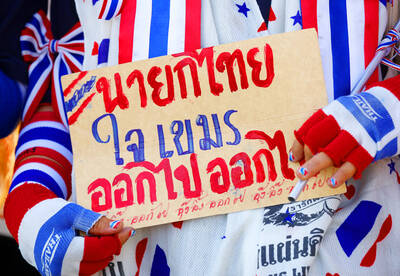At least 400,000 squatters blocking key drainage channels of a giant lake on the edge of the Philippine capital need to be uprooted to fix Manila’s flooding crisis, a government official said yesterday.
The squatters are among 1 million people living on the shoreline of Laguna de Bay, which will stay flooded for up to five months unless drastic action is taken, Laguna Lake Development Authority chief Edgardo Manda said.
“I have made a strong recommendation to remove these people from the danger zones and not allow them to go back,” Manda said of the 400,000 squatters who are living mostly on what was once marshy wetlands. “The authorities would probably need to erect barricades and station sentries in these areas.”
The dramatic recommendation comes as large parts of eastern Manila remain flooded 12 days after Tropical Storm Ketsana dumped the heaviest rains in more than four decades on the city, killing at least 298 people.
Manda and other officials have acknowledged that chaotic urban planning, or no planning at all, exacerbated the crisis, particularly around Laguna, where shantytowns, factories and housing developments have overtaken farms.
However, Manda said he realized removing squatters from around the lake would be a “political decision” that may not sit well with politicians so close to national elections in May next year.
In those polls, local officials as well as a new president are chosen.
About 300,000 of the squatters are living in and around an illegal open garbage dump on wetlands that block two connecting rivers that are meant to channel excess water from the lake into Manila Bay to the west.
“The channel is constricted,” Manda said, adding that clearing the squatters and garbage from the wetlands was key to allowing water to flow more freely.
About 100,000 other squatters live in houses on stilts on the lakeshore to the south, he said.
Aside from the 1 million people living near the immediate shoreline, which is likely to remain flooded for many months, at least 1 million others live in adjacent districts of eastern Manila that are also still under water.
Philippine President Gloria Arroyo’s chief aide, Eduardo Ermita, on Wednesday announced a Belgian firm had been hired to dredge the Pasig River.
“Definitely this will help,” Ermita said, but he did not address the issue of the squatters directly.
He also said the government was reviewing the process of granting permits to developers of residential areas along the 220km stretch of Laguna shoreline that were now partly submerged.
“These things must be looked into because we can see the effects,” he told reporters.
Aside from working out a way to unplug the Laguna lake area, the government has been trying to care for more than 315,000 homeless flood survivors who remain in schools, sports arenas and other makeshift evacuation centers.
The government has warned that disease outbreaks are highly likely for those living in the shelters, as well as in the flooded areas around Laguna, because of unsanitary conditions.

Eleven people, including a former minister, were arrested in Serbia on Friday over a train station disaster in which 16 people died. The concrete canopy of the newly renovated station in the northern city of Novi Sad collapsed on Nov. 1, 2024 in a disaster widely blamed on corruption and poor oversight. It sparked a wave of student-led protests and led to the resignation of then-Serbian prime minister Milos Vucevic and the fall of his government. The public prosecutor’s office in Novi Sad opened an investigation into the accident and deaths. In February, the public prosecutor’s office for organized crime opened another probe into

RISING RACISM: A Japanese group called on China to assure safety in the country, while the Chinese embassy in Tokyo urged action against a ‘surge in xenophobia’ A Japanese woman living in China was attacked and injured by a man in a subway station in Suzhou, China, Japanese media said, hours after two Chinese men were seriously injured in violence in Tokyo. The attacks on Thursday raised concern about xenophobic sentiment in China and Japan that have been blamed for assaults in both countries. It was the third attack involving Japanese living in China since last year. In the two previous cases in China, Chinese authorities have insisted they were isolated incidents. Japanese broadcaster NHK did not identify the woman injured in Suzhou by name, but, citing the Japanese

YELLOW SHIRTS: Many protesters were associated with pro-royalist groups that had previously supported the ouster of Paetongtarn’s father, Thaksin, in 2006 Protesters rallied on Saturday in the Thai capital to demand the resignation of court-suspended Thai Prime Minister Paetongtarn Shinawatra and in support of the armed forces following a violent border dispute with Cambodia that killed more than three dozen people and displaced more than 260,000. Gathered at Bangkok’s Victory Monument despite soaring temperatures, many sang patriotic songs and listened to speeches denouncing Paetongtarn and her father, former Thai prime minister Thaksin Shinawatra, and voiced their backing of the country’s army, which has always retained substantial power in the Southeast Asian country. Police said there were about 2,000 protesters by mid-afternoon, although

MOGAMI-CLASS FRIGATES: The deal is a ‘big step toward elevating national security cooperation with Australia, which is our special strategic partner,’ a Japanese official said Australia is to upgrade its navy with 11 Mogami-class frigates built by Japan’s Mitsubishi Heavy Industries, Australian Minister for Defence Richard Marles said yesterday. Billed as Japan’s biggest defense export deal since World War II, Australia is to pay US$6 billion over the next 10 years to acquire the fleet of stealth frigates. Australia is in the midst of a major military restructure, bolstering its navy with long-range firepower in an effort to deter China. It is striving to expand its fleet of major warships from 11 to 26 over the next decade. “This is clearly the biggest defense-industry agreement that has ever